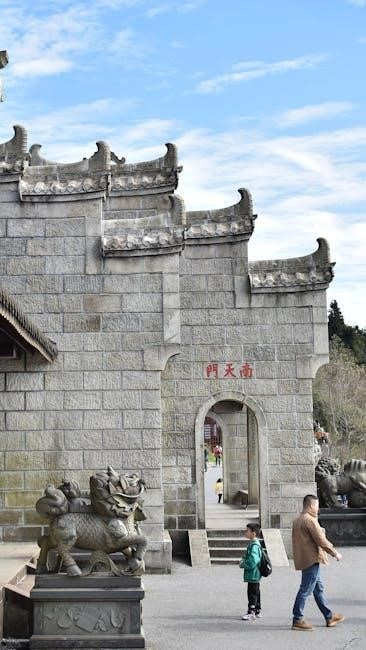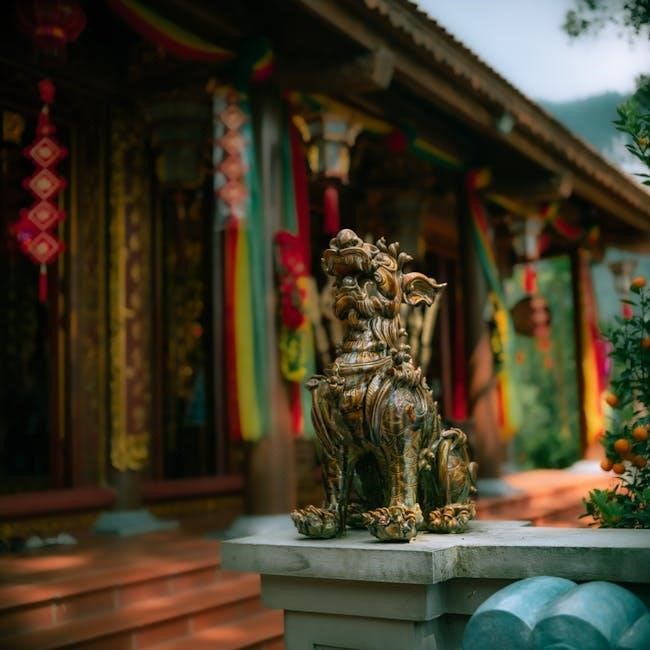
the practically complete guide to dragons
Dragons are legendary creatures that have captivated human imagination across cultures. These majestic beings, often depicted as powerful and wise, appear in mythology, folklore, and modern media. They symbolize strength, good fortune, or chaos, depending on cultural context. From ancient myths to modern fantasy, dragons continue to inspire stories, art, and popular culture, making them timeless symbols of fascination and intrigue.
Mythological Origins of Dragons
Dragons have their roots in ancient mythologies, where they were often depicted as powerful, serpent-like creatures. In many cultures, dragons symbolized natural forces, such as storms or water, and were sometimes associated with gods. European folklore typically portrays dragons as fire-breathing beasts, while Asian traditions often depict them as benevolent, wise rulers. These creatures were frequently linked to themes of power, creation, and destruction. The concept of dragons may have originated from the discovery of prehistoric fossils, inspiring legends of giant reptilian beings. Across various civilizations, dragons were revered or feared, reflecting human awe and curiosity about the unknown. Their enduring presence in mythology highlights their significance as symbols of both chaos and order, shaping cultural narratives and beliefs.
Folklore and Legends Surrounding Dragons
Folklore and legends about dragons vary widely across cultures, often reflecting societal fears and aspirations. In European tradition, dragons are frequently depicted as fire-breathing, evil creatures that terrorize villages, as seen in the legend of Saint George and the Dragon. Conversely, in many Asian cultures, dragons are revered as benevolent symbols of good fortune and prosperity, such as the Chinese Long. These creatures are often associated with elemental forces—water, fire, or earth—and are said to possess magical powers. Legends also tell of dragons hoarding treasure, serving as guardians of sacred sites, or possessing wisdom and prophetic abilities. The dual nature of dragons as both fearsome and noble highlights their complex role in human storytelling. These tales have endured through generations, influencing art, literature, and popular culture, and remain a source of fascination today.
Literary and Cultural Representations of Dragons
Dragons have been a cornerstone of literature and culture, appearing in countless stories, poems, and artworks. In J.R.R. Tolkien’s The Hobbit, Smaug embodies greed and destruction, while in Cressida Cowell’s How to Train Your Dragon, dragons are portrayed as loyal companions. Literature often uses dragons as metaphors for power, transformation, or chaos. Culturally, dragons symbolize diverse values: in Europe, they are frequently depicted as fire-breathing villains, whereas in Asia, they represent good fortune and wisdom. Modern media, such as Game of Thrones and Critical Role, continues to evolve dragon lore, blending traditional myths with fresh narratives. These representations reflect societal values, fears, and aspirations, making dragons timeless and universal symbols in human storytelling. Their enduring presence in literature and culture showcases their adaptability and the deep fascination they inspire across generations and continents.

Cultural Significance of Dragons
Dragons hold profound cultural significance, symbolizing power, wisdom, and good fortune in many societies. Their imagery reflects deep-rooted values, fears, and aspirations across diverse traditions and regions globally.
Symbolism and Meaning of Dragons Across Cultures
Dragons carry diverse symbolic meanings across cultures, reflecting their significance in human societies. In Eastern cultures, they often represent benevolence, power, and good fortune, as seen in Chinese dragons associated with prosperity. In contrast, Western traditions frequently depict dragons as fire-breathing, destructive beings symbolizing chaos or evil; This duality highlights the complexity of dragon symbolism, which varies widely from one cultural context to another. Some cultures view dragons as guardians of sacred knowledge or natural elements, while others see them as fearsome adversaries in myths and legends. Their imagery has been used to convey moral lessons, embody national identity, and inspire artistic expression. This rich symbolism underscores why dragons remain enduring and versatile figures in both ancient and modern narratives.
The Role of Dragons in Ancient Mythologies
Dragons have played a central role in ancient mythologies, often symbolizing power, creation, and the forces of nature. In Egyptian mythology, the dragon-like creature Wadjet represented royalty and protection, while in Norse mythology, dragons like Fafnir and Jörmungandr were associated with destruction and chaos. In Chinese culture, the dragon symbolized imperial authority and good fortune, embodying the balance of yin and yang. Similarly, in Mesopotamian myths, dragons were linked to cosmic creation, such as the dragon Tiamat, who personified the primordial sea. These creatures often served as metaphors for natural phenomena or divine power, shaping the cultural and religious narratives of ancient civilizations. Their roles varied widely, from benevolent deities to fearsome adversaries, reflecting the diversity of human experiences and beliefs across different societies and time periods.
Historical References to Dragons in Art and Literature
Dragons have been a recurring theme in art and literature throughout history, often symbolizing power, destruction, or wisdom. In medieval European art, dragons were frequently depicted as fire-breathing beasts, such as in the legend of Saint George and the Dragon. Literature, like J.R.R. Tolkien’s The Hobbit, features dragons as guardians of treasure, with Smaug embodying greed and destruction. Similarly, in ancient Norse sagas, dragons like Fafnir were central to tales of heroism and tragedy. In Asian art, dragons were often portrayed as benevolent creatures, appearing on pottery, scrolls, and imperial robes. Literary works, such as Chinese myths, describe dragons as symbols of imperial power and good fortune. Renaissance art also incorporated dragons, often as allegorical figures in religious or mythological scenes. These historical references highlight the enduring fascination with dragons, showcasing their versatility as cultural and artistic motifs across time and regions.

Types of Dragons
Dragons vary widely across cultures, from the fire-breathing Western dragons to the serpent-like Eastern dragons symbolizing good fortune. Modern media has introduced diverse interpretations, enriching their roles in mythology, literature, and art.
Dungeons & Dragons: The Role of Dragons in the Game
In Dungeons & Dragons (D&D), dragons are iconic creatures, serving as powerful antagonists, guardians, or even allies. They embody immense strength, intellect, and magical prowess, often symbolizing ultimate challenges for players. Each dragon type, such as chromatic or metallic, has distinct traits and alignments, influencing their interactions with adventurers. For instance, silver dragons are known for their wisdom and benevolence, while red dragons are feared for their destructive power. Dragons in D&D are not just enemies; they also play roles in shaping worlds, hoarding treasures, and preserving ancient secrets. Their presence enriches storytelling, offering players unforgettable encounters and opportunities for heroic deeds. Whether as fearsome foes or noble beings, dragons are central to the D&D experience, embodying the game’s spirit of adventure and fantasy.
Mythical Creatures: Dragons in Different Cultures
Dragons appear in various forms across global mythologies, reflecting cultural values and beliefs. In Eastern cultures, like China and Japan, dragons symbolize good fortune, prosperity, and imperial power. The Chinese dragon, Long, is benevolent, often associated with water and fertility. Conversely, Western traditions frequently depict dragons as fire-breathing, evil beings, such as European folklore’s fire-breathing monsters that terrorize villages. Norse mythology features Jörmungandr, the Midgard Serpent, a sea dragon tied to Ragnarök. Each culture’s dragon mythology highlights unique aspects, such as symbolism, behavior, and roles in creation myths. These diverse representations illustrate the universal fascination with dragons, adapting to the values and fears of their societies. By exploring these differences, we gain insight into the cultural significance and enduring appeal of dragons worldwide.
Modern Interpretations of Dragons in Media
In modern media, dragons have evolved into versatile characters, blending tradition with contemporary twists. Films like How to Train Your Dragon portray dragons as intelligent, loyal companions, shifting from fearsome beasts to empathetic friends. Television series such as Game of Thrones feature dragons as symbols of power and destruction, while also exploring their emotional bonds with human characters. Literature, like Cressida Cowell’s books, reimagines dragons in humorous and adventurous contexts. Video games, such as Skyrim and World of Warcraft, allow players to interact with dragons, whether as allies or adversaries, further cementing their role in modern storytelling. These interpretations highlight dragons’ adaptability, ensuring their relevance in today’s entertainment landscape while maintaining their timeless allure as mythical creatures.

Dragons in Modern Times
Dragons in modern times are celebrated in pop culture, games, and art, symbolizing power and fantasy. Their enduring appeal continues to captivate global audiences, inspiring new stories and designs.
Pop Culture Appearances of Dragons
Dragons have become iconic figures in modern pop culture, appearing in films, television shows, and video games. In Game of Thrones, they symbolize power and legacy, while in How to Train Your Dragon, they embody friendship and understanding. These portrayals often blend traditional mythological traits with contemporary storytelling, making dragons relatable and engaging to new audiences. Additionally, dragons are central to popular franchises like Dungeons & Dragons, where they serve as formidable adversaries or noble allies, further cementing their place in modern entertainment. Their versatility allows them to fit into various narratives, ensuring their enduring appeal across different mediums and generations.
The Role of Dragons in Gaming and Fantasy
Dragons play a pivotal role in gaming and fantasy, often serving as iconic antagonists or powerful allies. In Dungeons & Dragons, they are central to many campaigns, embodying challenges and treasures for adventurers. Their presence in video games like Skyrim and World of Warcraft enhances immersive storytelling and world-building. Whether as fire-breathing foes or noble guardians, dragons inspire awe and curiosity. Their versatility allows them to fit seamlessly into various game narratives, from high fantasy to modern RPGs. This enduring appeal ensures dragons remain integral to the gaming and fantasy landscape, captivating audiences with their legend and might.

The Cultural Impact of Dragons Today
Dragons continue to captivate modern culture, inspiring art, literature, and media. In popular series like Game of Thrones and House of the Dragon, they symbolize power and legacy, resonating with global audiences. Their presence in video games, such as The Elder Scrolls V: Skyrim, allows players to engage with these mythical creatures, fostering a sense of adventure and epic storytelling. Beyond entertainment, dragons influence fashion, tattoos, and even corporate branding, reflecting their timeless appeal. They also serve as cultural symbols, embodying both fearsome destruction and benevolent wisdom. This dual nature makes dragons versatile and enduring icons, ensuring their relevance in contemporary society. Their ability to inspire creativity and evoke emotion solidifies their lasting impact on culture today.